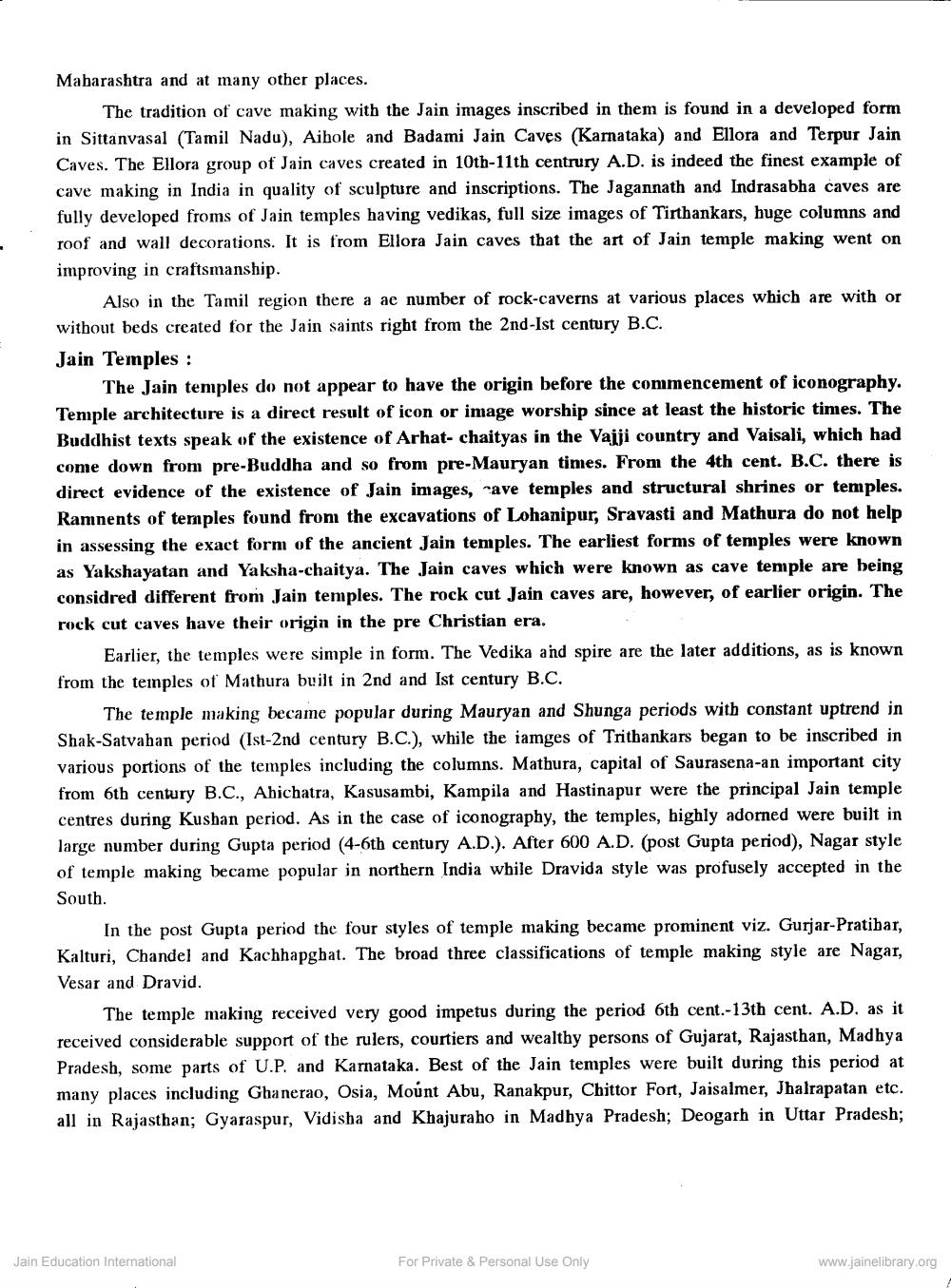________________
Maharashtra and at many other places.
The tradition of cave making with the Jain images inscribed in them is found in a developed form in Sittanvasal (Tamil Nadu), Aihole and Badami Jain Caves (Karnataka) and Ellora and Terpur Jain Caves. The Ellora group of Jain caves created in 10th-11th centrury A.D. is indeed the finest example of cave making in India in quality of sculpture and inscriptions. The Jagannath and Indrasabha caves are fully developed froms of Jain temples having vedikas, full size images of Tirthankars, huge columns and roof and wall decorations. It is from Ellora Jain caves that the art of Jain temple making went on improving in craftsmanship.
Also in the Tamil region there a ae number of rock-caverns at various places which are with or without beds created for the Jain saints right from the 2nd-Ist century B.C. Jain Temples :
The Jain temples do not appear to have the origin before the commencement of iconography. Temple architecture is a direct result of icon or image worship since at least the historic times. The Buddhist texts speak of the existence of Arhat- chaityas in the Vajji country and Vaisali, which had come down from pre-Buddha and so from pre-Mauryan times. From the 4th cent. B.C. there is direct evidence of the existence of Jain images, rave temples and structural shrines or temples. Ramnents of temples found from the excavations of Lohanipur, Sravasti and Mathura do not help in assessing the exact form of the ancient Jain temples. The earliest forms of temples were known as Yakshayatan and Yaksha-chaitya. The Jain caves which were known as cave temple are being considred different from Jain temples. The rock cut Jain caves are, however, of earlier origin. The rock cut caves have their origin in the pre Christian era.
Earlier, the temples were simple in form. The Vedika and spire are the later additions, as is known from the temples of Mathura built in 2nd and Ist century B.C.
The temple making became popular during Mauryan and Shunga periods with constant uptrend in Shak-Satvahan period (Ist-2nd century B.C.), while the iamges of Trithankars began to be inscribed in various portions of the temples including the columns. Mathura, capital of Saurasena-an important city from 6th century B.C., Ahichatra, Kasusambi, Kampila and Hastinapur were the principal Jain temple centres during Kushan period. As in the case of iconography, the temples, highly adorned were built in large number during Gupta period (4-6th century A.D.). After 600 A.D. (post Gupta period), Nagar style of temple making became popular in northern India while Dravida style was profusely accepted in the South.
In the post Gupta period the four styles of temple making became prominent viz. Gurjar-Pratibar, Kalturi, Chandel and Kachhapgbat. The broad three classifications of temple making style are Nagar, Vesar and Dravid.
The temple making received very good impetus during the period 6th cent.-13th cent. A.D. as it received considerable support of the rulers, courtiers and wealthy persons of Gujarat, Rajasthan, Madhya Pradesh, some parts of U.P. and Karnataka. Best of the Jain temples were built during this period at many places including Ghanerao, Osia, Mount Abu, Ranakpur, Chittor Fort, Jaisalmer, Jhalrapatan etc. all in Rajasthan; Gyaraspur, Vidisha and Khajuraho in Madhya Pradesh; Deogarh in Uttar Pradesh;
Jain Education International
For Private & Personal Use Only
www.jainelibrary.org




